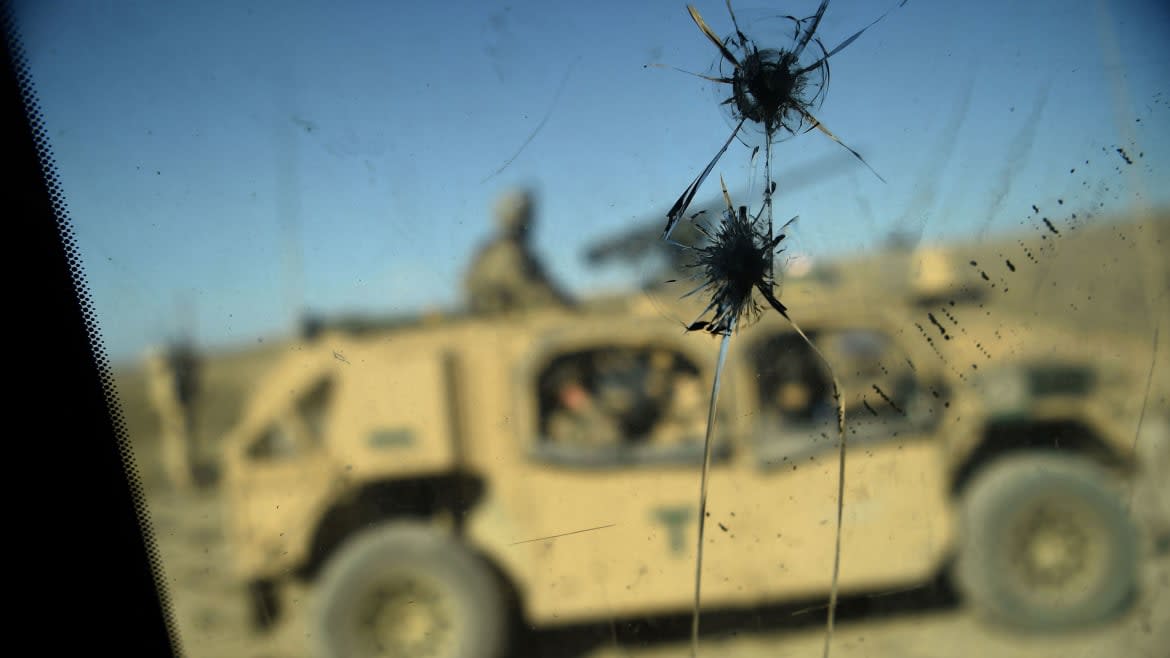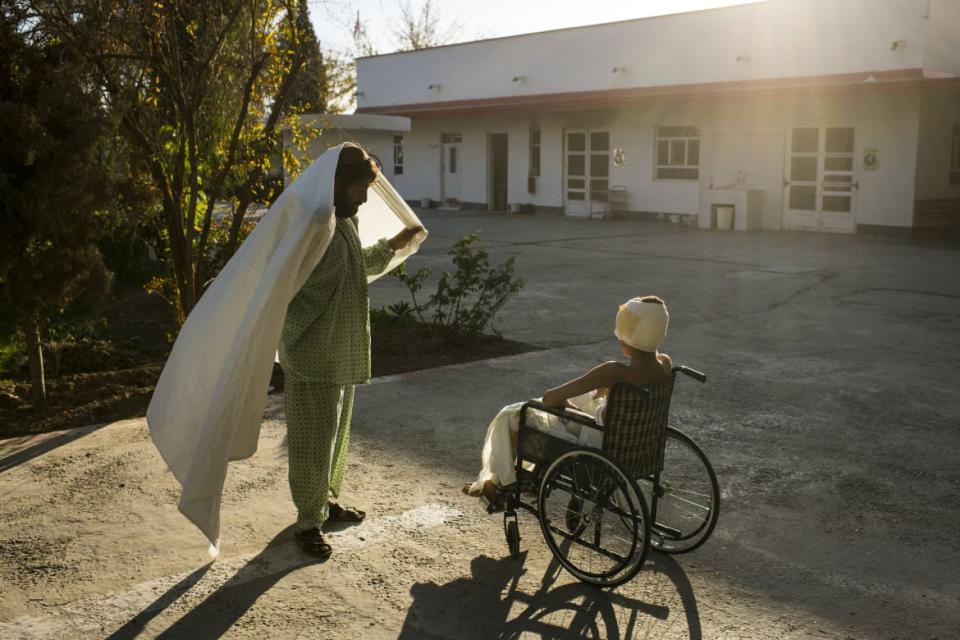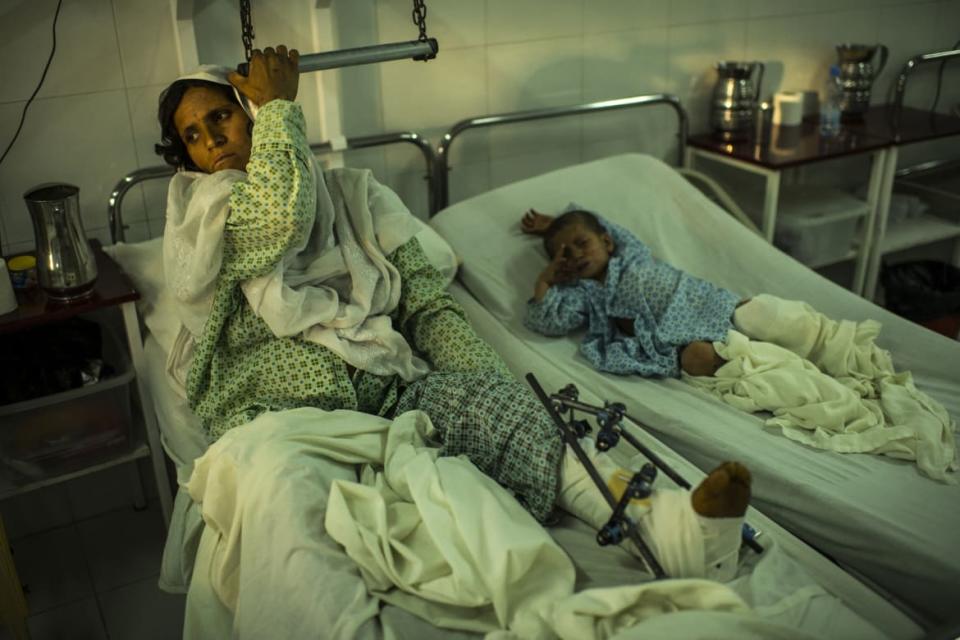The U.S. in Afghanistan, Talking Peace and Waging War, Doesn’t Count All The Civilians It Slaughters

LOY MANDA, Afghanistan–Bloodied and broken, 13 members of an extended family were lifted, one by one, from a minibus and placed in wheelchairs and on hospital beds with clean white sheets. The out patient department at Emergency Hospital in Helmand’s capital Lashkar Gah was soon beyond capacity. Nurses from throughout the building rushed to assist.
The victims ranged in age from four to fifty. They’d been at home on the afternoon of November 24, 2018, when two Taliban fighters entered their compound in the village of Loy Manda, in Helmand’s Nad-i Ali District. Obaidullah, the patriarch of the family, pleaded with the fighters to leave, but before they did, they fired over a wall at a passing Afghan and American military convoy.
In response, an American warplane—an A-10 ”Warthog”—made two strafing runs over the house. Hundreds of rounds of ammunition—bullets the size of large carrots—fired by a weapon designed to disable armoured tanks, poured out of the plane’s Gatling gun. The two Taliban fighters had fled. Instead, Obaidullah and his 15-year-old son Esmatullah were killed; 13 others suffered broken bones and shrapnel injuries from head to toe. One boy, 14-year-old Ehsanullah, lost both his eyes.
In May this year, The U.S. Department of Defense released its Annual Report on Civilian Casualties. In table format, an entry for Helmand on the same date states: “Operation Type: Air. Killed: 0. Injured: 4.”
DEATH BY THE NUMBERS
The war in Afghanistan will soon enter its 19th year. In Qatar, U.S. and Taliban representatives have been hashing out a preliminary agreement that would see a withdrawal timeline for international troops in return for a Taliban guarantee that it would disavow terrorist groups with transnational aspirations seeking to use Afghanistan as a base.
The Taliban Scoff at Trump’s Afghan Peace Talks Bluff
In contrast, on the battlefield, both sides are ramping up their military campaigns in an effort to strengthen their negotiating positions. As a result, the number of civilians caught in the crossfire is increasing, too.
In its latest report on civilian casualties, the United Nations Assistance Mission to Afghanistan (UNAMA) found that this year, for the first time since it began counting, pro-government forces, including international forces, were responsible for more civilian deaths than the Taliban and the so-called Islamic State’s Afghanistan branch combined. The primary reason for this is an escalation of the U.S. air war in Afghanistan.
In a conflict that has been unpopular with the American public—and now its president—for years now, the downplaying of the number of Afghan civilians killed in the crossfire is one way the U.S. military—which one senses is more committed to Afghanistan than its political leaders—can mitigate opposition at home.
Today, the rented house Obaidullah’s family was in when it was struck by the warplane last November, is empty. During the day, columns of sunlight pour through a dozen watermelon-sized holes in the roof: evidence of the missile-like bullets that also tore holes through its inhabitants.
After they were discharged from hospital, Obaidullah’s two wives and their surviving children moved to the village of Shawal, which is under Taliban control, further north in the same district, with Obaidullah’s brothers.
Day to day security in most rural parts of Afghanistan isn’t so much dictated by who controls the area as by how far it is from the front line. Nor does the side of a front line one chooses to live on necessarily indicate sympathy for one faction or the other.
Loy Manda, where the family lived when their house was struck, was the front line. They hoped moving farther from it, even though that meant going deep into Taliban territory, would be safer. The escalation of the air war, however, means that calculation is no longer a reliable measure of safety.
‘TENDENTIOUS PRONOUNCEMENTS’
Ehsanullah was 14 when he was brought into the emergency hospital last November. His face was a mess of raw flesh and dried, rusty blood. He had already lost one eye; the other was ruptured and would later be removed by surgeons. The rest of his body was bruised, broken, burned and punctured by debris thrown out as the rounds impacted around him.
Without sight, his hearing has become increasingly sensitized, and the sound of aircraft terrifies him. Air strikes are even more common in Shawal now than they were in Loy Manda. “I’m always scared of the aircraft now,” he says. “I’m scared they’re going to target us again.”

Ehsanullah, 14, has two ruptured eyes and several leg and abdominal injuries. His uncle, Sardar Wali, sits with him in the garden at Emergency hospital for the war wounded in Lashkar Gah, Helmand. Sardar Wali wept at times while crouching beside his nephew. 13 members from two families, including his, were admitted on November 24, 2018 at around 4:30PM.\n\n13 in total were admitted to Emergency hospital for the war wounded in Lashkar Gah, Helmand, on the evening of November 24, 2018, after an airstrike on their home in the village of Loy Manda in Nad-i Ali District. Obaidullah, the patriarch of the family, and another of his sons, Esmatullah, were killed in the strike. In total, 12 women and children were injured and brought to Emergency, including a pregnant mother, Qarara, and an elderly man, all of whom had suffered shrapnel injuries to various parts of their bodies. \n\nFamily members explained that Taliban fighters had sought shelter from military aircraft in their home despite the residents pleading for them to leave. The next thing they knew their compound, home to two families, was being \"bombed\" by an aircraft which they identified, after I showed some family members video footage of one, an American A-10 \"Warthog\" warplane. \n\nA spokesperson for the International Resolute Support military mission in Kabul, SFC Debra Richardson provided me with a statement in response to my enquiries that read as follows: \"We are still looking into the details. We know U.S. forces, accompanying their Afghan security partners, called in self-defense air support against a building from which the Taliban were shooting. Too often the Taliban use civilians as hostages and human shields. It is often difficult to discern the presence of non-combatants inside structures when the Taliban are shooting from those locations. Enough violence, the Taliban should seriously engage in talks for a political solution instead of engaging in more pointless fighting. We have the duty to be precise. We own every munition we fire--the bullets from our rifles as well as the rockets on each strike. We are the most precise force in the history of warfare, ever, but this is not enough for us--we seek to improve and match higher standards every day.
On top of this, Ehsanullah requires help with even the simplest of tasks. “Now I can’t do anything; I can’t even find my way,” he says. “Even when I want to move I need the help of someone.” That job has fallen to his younger brother, Rahmatullah, who never leaves his brother’s side. Rahmatullah himself arrived in the emergency room that day with his intestines resting on his stomach.
The U.S.-led Resolute Support military mission in Afghanistan refused to respond to several recent enquiries about the incident and the DOD’s accounting of civilian victims. The U.S. military maintains that it makes condolence payments to civilian victims of its operations, but a Resolute Support spokesperson was unable to confirm whether such a payment had been made to Obaidullah’s family. The family says they received nothing.
The DoD report states its “assessments seek to incorporate all available information... DoD updates existing assessments if new information becomes available, including new information received from NGOs or other outside organizations.”
The details of this and The Daily Beast’s January report were both supplied to Resolute Support’s public affairs office, which again refused to address the issue.
How U.S. Bombs Tore One Family to Shreds in Afghanistan
UNAMA, which has sparred with both Resolute Support and the Taliban over methodologies concerning the assessment of civilian casualty figures, issued an unusually biting statement in an August 3 press release: “... all parties to the conflict have a poor track record on investigating, publicly reporting their findings and taking appropriate follow-up measures to address incidents in which civilians are killed or injured.” The statement continued: “UNAMA recognizes that in the context of the war in Afghanistan, all parties are prone to issue tendentious pronouncements.”
Andrew J. Bacevich, professor emeritus of history and international relations at Boston University told The Daily Beast, “The U.S. military is deeply invested in a self-image that is undermined by evidence that it has caused civilian casualties. U.S. forces want to be seen as using violence with great precision–killing only those they intend to kill. Evidence to the contrary damages the prestige of the armed services and can undercut their standing in the eyes of the American people. In that sense, the issues here go well beyond Afghanistan per se.”
This isn’t an isolated case.
When Obaidullah’s family moved to Shawal after leaving the hospital, in the very same village was another family who had also been bombed.
On October 10 last year, six weeks before the Loy Manda strike, Abdul Ahad was at home with his family in the farming village of Shawal when the sounds of fighting began nearby. Shawal was on the northern—Taliban-controlled—side of a wide irrigation canal that still marks the front line in Nad-i Ali district today, so while airstrikes were common, ground engagements like this were rare.
He told the story under the shade of a tree outside Shawal recently; it was so hot that steam didn’t rise from his cup of boiling green tea. The jet engines of American bombers could be heard wavering on the wind miles above.

L to R: Qarara and her son Hedayat 94) recover in the female and children's ward at Emergency Hospital for the war wounded in Lashkar Gah, Helmand Province. They were admitted on November 24, 2018, after Taliban fighters had used their house to fire on a passing American and Afghan Army convoy in Loy Manda, Nad-i Ali District, Helmand Province and the Americans called in an airstrike. Two family members were killed, the husband and father, Obaidullah, and his son Esmatullah, while 13 in total were injured. The soldiers provided first aid for the wounded before they were brought by Loy Manda locals to Emergency in Lashkar Gah.\n\nIn a statement by a spokesperson for the International Resolute Support military mission provided to me after alerting them to the incident, said:\n\n\"We are still looking into the details. We know U.S. forces, accompanying their Afghan security partners, called in self-defense air support against a building from which the Taliban were shooting. Too often the Taliban use civilians as hostages and human shields. It is often difficult to discern the presence of non-combatants inside structures when the Taliban are shooting from those locations. Enough violence, the Taliban should seriously engage in talks for a political solution instead of engaging in more pointless fighting. We have the duty to be precise. We own every munition we fire--the bullets from our rifles as well as the rockets on each strike. We are the most precise force in the history of warfare, ever, but this is not enough for us--we seek to improve and match higher standards every day.
Ahad’s house was one point of a triangle, with American and Afghan special forces on a second point and Taliban fighters on a third. Both groups were shooting across, but not toward his house. The soldiers were a quarter mile away, the Taliban, he said, about twice that distance. Some 70-80 yards away was another large compound, inside which four families lived in separate houses. Haji Salaam was in one of them with two of his brothers and their wives and children. When he sensed the fighting getting close he told everyone to stay inside.
Out of nowhere, Abdul Ahad felt the thump of two almost simultaneous explosions. But the airstrikes hadn’t hit the compound from which the Taliban were firing. They’d struck Haji Salaam’s house, where he and his family had been sheltering, and it was now engulfed in a cloud of smoke and dust.
Ahad waited until the fighting finished and then made his way quickly across the field to his neighbor’s compound. The outer walls were still intact but once inside he saw that at least one of the houses had been completely levelled.
Afghan and American soldiers arrived in more than a dozen armoured vehicles within minutes, as did other neighbors. Haji Salaam had survived. “When they came to the house,” he says, “they claimed there was Taliban in the house firing at us. I told them we are not Taliban, we are all civilians.”
The Americans and their Afghan counterparts stayed for almost an hour. Some helped while others stood guard in case of a Taliban ambush. By the time they’d left, 11 dead bodies had been pulled from the rubble. Seven of them were less than nine years of age. Five under the age of 15 were injured but survived.
According to the DOD report, no one was injured in the strike, and only one civilian was killed.
Got a tip? Send it to The Daily Beast here
Get our top stories in your inbox every day. Sign up now!
Daily Beast Membership: Beast Inside goes deeper on the stories that matter to you. Learn more.

